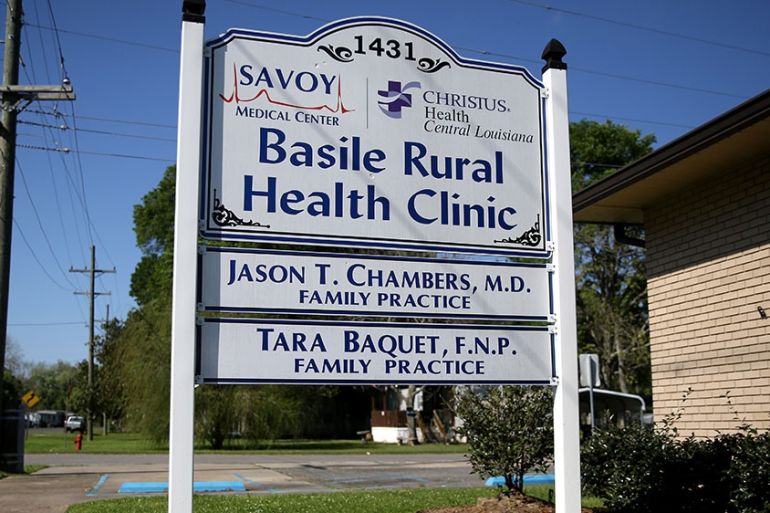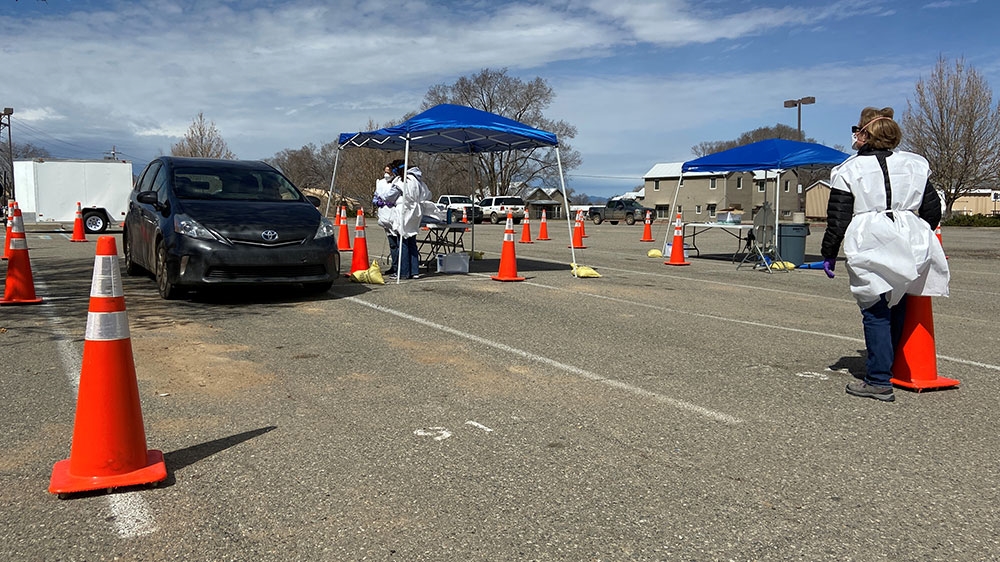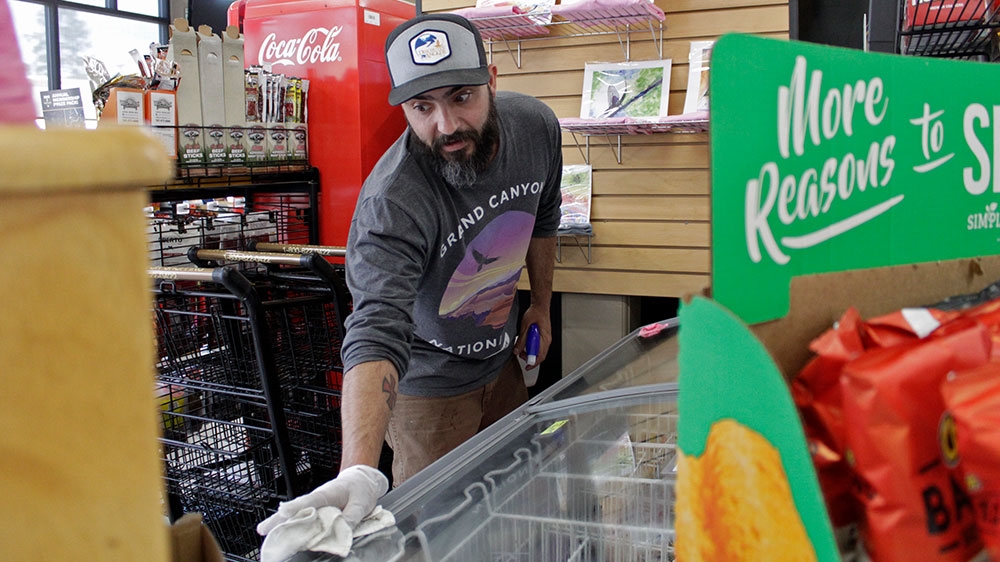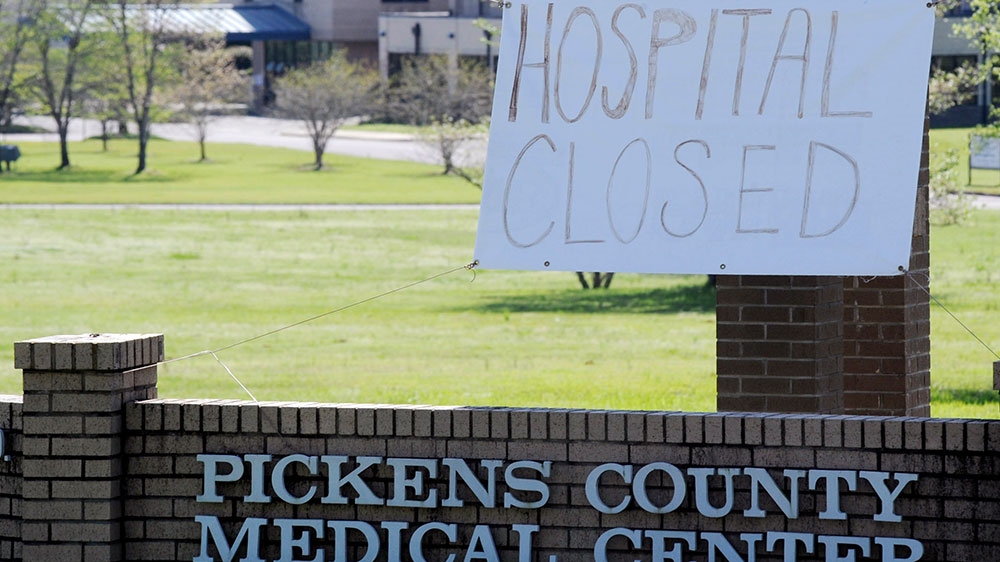Rural US hospitals struggle as coronavirus pandemic creeps closer
While urban centres have been hit the hardest, rural areas appear wholly unprepared for a large-scale medical emergency.

Carter County, Missouri, does not have a single hospital, hospital bed or ventilator for any of its 6,200 residents. Of the six counties on its boundaries, only one – Butler County – has any intensive care unit (ICU) beds. The other five have no hospital beds at all.
“The nearest hospital is 45 minutes away,” said Michelle Walker, administrator at Carter County Health Center, a small outpatient facility, “but I couldn’t say how many ICU beds there are there.”
Keep reading
list of 4 itemsMexico’s teachers seek relief from pandemic-era spike in school robberies
‘A bad chapter’: Tracing the origins of Ecuador’s rise in gang violence
Why is the US economy so resilient?
The fear of the impending health crisis for rural areas of the United States due to the coronavirus pandemic is laid bare in Carter County and dozens, if not hundreds, of counties in similar situations across the country.
While the coronavirus pandemic in the US has spread quickest in urban centres, the country’s rural regions appear wholly unprepared for a large-scale medical emergency. Thirty-eight percent of counties in Kansas have no hospitals, while more than half have no ICU beds, according to data analysis by Kaiser Health News. More than 100,000 residents of Idaho have no hospital beds in their counties.
Around 60 million Americans – almost 20 percent of the US population – live in rural regions.
Rural hospitals have been left understaffed and under-resourced since long before the coronavirus pandemic arrived. A report published in February by the Chartis Center for Rural Health, a research group, found that 120 rurally-based hospitals closed over the last decade, with 2019 seeing the highest number, at 19 closures.
“States in the Southeast and lower Great Plains have borne the brunt of the closure crisis,” the report finds. Almost one in four are still at risk of closing. Many are states that chose not to expand the Medicaid programme that dates from the era of US President Barack Obama – an initiative almost entirely paid for by the federal government. What’s more, predominantly rural states such as Maine, Alaska, Wyoming and Vermont have to deal with some of the highest monthly health insurance premiums in the country.

“Rural residents may also be more likely to have jobs without paid sick time, or to be self-employed, which may increase pressure to work when there aren’t sheltering orders in place,” says Erika Ziller, director of the Maine Rural Health Research Center at the University of Southern Maine.
Though sparsely-populated states have broadly been reporting lower infection rates until now, they also have some of the weakest healthcare infrastructure. Missouri’s Carter County Health Center relies on a staff of five full-time workers, including Michelle Walker, and three part-time employees. As of March 31, just 25 people had been tested there for COVID-19, with three test results returning positive. Last weekend, the county reported its first coronavirus-related death. Walker preferred not to comment on what she thinks the state or federal governments should be doing to help under-resourced countries such as hers, but she noted the biggest challenge health workers are facing is local residents not taking physical separation seriously.

Home to about 10,000 people spread over an area larger than the island of Cyprus, Sublette County in western Wyoming reported just one COVID-19 infection as of Tuesday. Statewide, there have been only 212 cases, and as of this week, Wyoming is the last in the country without a reported COVID-19-related death.
But while exposure levels in Sublette County have been low, if an outbreak was to take hold, the consequences for its residents could be dire. The county has a public health facility and a rural clinic, but no hospitals or beds. The nearest ICU is in the city of Jackson, 124km (77 miles) across the Gros Ventre mountain range to the north. Jackson’s Teton County, however, has recorded the second-highest number of coronavirus cases in the state and serves 24,000 residents, including the Grand Teton and Yellowstone National Parks, which see millions of visitors a year.
“[Rural communities] are not necessarily at greater risk because it is a lot easier to socially distance ourselves compared to an individual in a city, so our chance of exposure is very low,” said Emily Ray of the Sublette County Rural Health Care District. “But another aspect of that is that we are the only county in the state without a hospital. If all other surrounding hospitals were full or unable to take a very sick patient in need of a hospital for a long period of time, we cannot keep them here and provide the proper care that they need to survive.”
In April 2018, the county was denied a $28m loan by the US Department of Agriculture’s rural development division to build a critical access hospital in Pinedale, with the agency citing the scope of the project as being too big.
Some rural hospitals have also abruptly shut their doors in recent months, citing financial difficulties and a lack of support by the medical community.

Others, however, have sprung into action, anticipating a possible crisis in their communities. Sublette County pooled its public health, emergency management and sheriff’s office resources two months prior to its first COVID-19 case to ready itself to respond. Jay says volunteers from the community have gone “above and beyond” in helping health workers and elderly residents. And while nationwide there are about 46,500 medical ICU beds, a similar number could be deployed in an emergency situation, making for one bed for every 3,660 residents.
Worst yet to come
Experts say, however, that the worst is yet to come for rural areas.
Analysis of activity tracked through people’s mobile phones by Unacast, a location data platform, shows that Wyoming residents have been doing particularly poorly at social distancing, coming last of all 50 US states in average mobility, or distance driving, and other key indicators.
People in Montana and Idaho have also been slow to curtail their movements. Missouri, seen as being one of the states slowest to react to the crisis, only ordered a statewide stay-at-home order on Friday, which started this week. Missouri has more than 2,800 coronavirus cases and 65 deaths.
“There needs to be some centralised planning,” said Ziller, “to make sure that rural places are not ignored or underserved during the distribution of essential resources like PPE [personal protective equipment], testing supplies, and ventilators.”